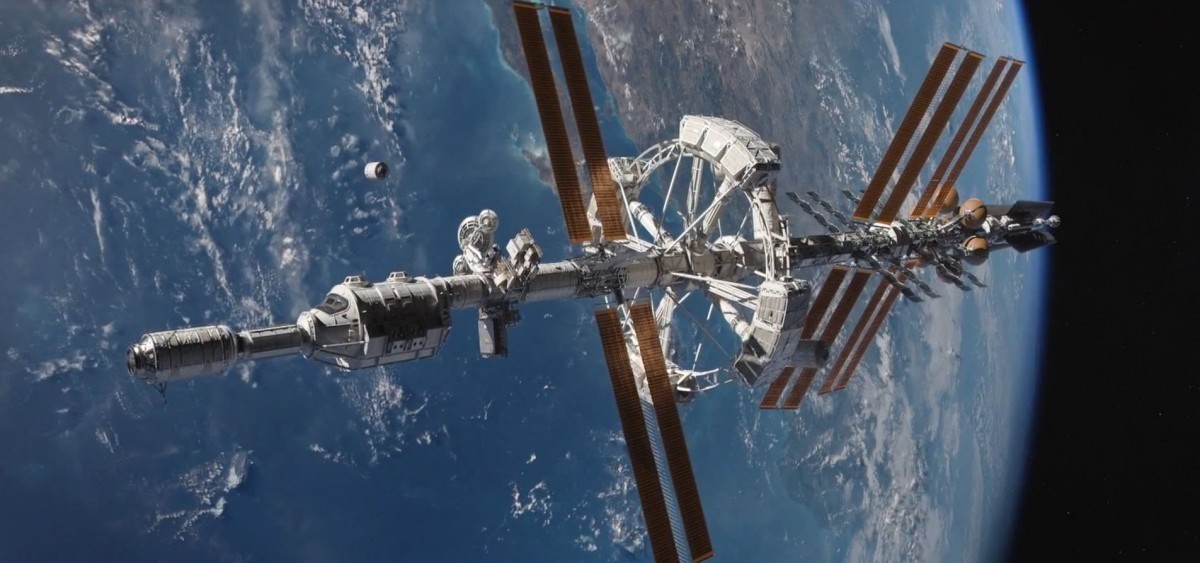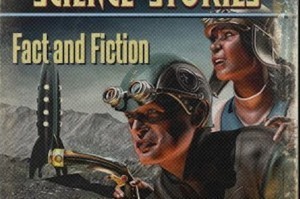In The Martian, journeys to Mars are made possible through a large spacecraft known as the Hermes. Unlike the Apollo program, where each trip to the Moon required a separate spacecraft, the fictional Ares program uses the Hermes as a taxi to between Earth and Mars. Individual missions dock with the Hermes, but the Hermes simply makes the rounds between Earth and Mars over and over. While the Hermes is a work of fiction, it’s based in well established science.

To have a large spacecraft that passes Earth and Mars with each orbit, you need some kind of thrust to adjust your orbit. In principle, chemical rockets could do the job, but they aren’t well suited for it. Chemical rockets are great for producing a large thrust in a short time, but a craft like the Hermes would need gradual thrust over longer periods. This can be done with ion drives, which accelerate charged particles at high speeds. In the novel, ion drives accelerate the Hermes at a constant 2 mm/s2, which is enough to continually adjust the orbit to match Earth and Mars. While we don’t yet have drives powerful enough for a craft like Hermes, ion drives are being used in missions such as the Dawn spacecraft currently at Ceres.
The only real disadvantage of ion drives is calculating their trajectories. If a spacecraft is continuously accelerating, its trajectory has to be determined computationally. This posed a real challenge for Andy Weir as he was writing the book. To get realistic trajectories for the Hermes he had to write a program to calculate them, and fiddle with parameters until he got a set of trajectories that worked. You can see the resulting trajectories here.












Comments
I think there is an unfinished sentence here: “The Hohmann transfer orbit, as it came to be known, relies on Earth and Mars to be in the right positions relative to each other so that a spacecraft in a Hohmann orbit.” … can transfer to lower orbits around each planet?
Also, presumably Hermes’ acceleration should be 2 mm/s^2.
Yes. I’ve updated it now.
To make an ordinary rendezvous with a Mars Ascent Vehicle (MAV), Hermes would have to enter low Mars orbit. In the Neil DeGrasse Tyson trailer for the movie he said the Hermes departs from low earth orbit. This wrecks Weir’s trajectory. At 2 mm/s^2, it would take Hermes more than a month to spiral out of earth’s gravity well from low earth orbit.
Also a rocket doesn’t have constant acceleration. As reaction mass is expelled, the ship becomes less massive. With constant thrust and decreasing mass, acceleration increases. Lewis says 2 mm/s^2 towards the end of the book. When Hermes departed earth it would have had double the mass and thus it’s acceleration would have been 1 mm/s^2. It would have taken around two months to spiral out of earth’s orbit.
According to the book, however, the Hermes had VESIMR engines. This engine is a real concept, and rolls around the idea of being able to change the specific impulse of the engine. The more you give up from efficiency, the more thrust you gain. So in theory it is possible that the Hermes could switch between at least two engine modes. One with high efficiency but low thrust, which is what they would use with the interplanetary long burn, and the other with high thrust but low efficiency, which would be optimal for orbital maneuvers like establishing/leaving orbit, and orbital rendezvous.
So as a tl;dl; version: with a VESIMR engine, this is quite possible by changing the engine to a higher thrust mode.
On page 395 Lewis says Hermes can do 2 mm/s^2. This is when they need to rendezvous with Watney’s MAV which hadn’t attained the speed they’d hope for. So this is a time when they need maximum thrust. 2 mm/s^2 is the max they can achieve, even after the Hermes has expelled most of its mass as reaction mass.
Nice try, but the Variable Impulse of VASIMR doesn’t salvage this impossibly trajectory.
Do you know anything about orbital physics? Coming in on a Hohmann-like orbit from mars, the Hermes would be in a parabolic orbit with a periapsis close to the surface of Earth. Even with no engines, as long as the periapsis was out of the atmosphere, the ship would still continue to intersect the orbit of Mars, just not at a time to get an encounter.
Henry Morgan writes “Do you know anything about orbital physics? Coming in on a Hohmann-like orbit from mars, the Hermes would be in a parabolic orbit with a periapsis close to the surface of Earth.”
Completely wrong. Coming from Mars on a Hohmann transfer, the Hermes would enter earth’s sphere of influence on a hyperbolic orbit wrt to earth. The hyperbolic excess velocity would be in the neighborhood of 3 km/s.
To answer your question, yes I do know something about orbital physics. You, on the other hand, do not.
The second half of your comment is also pretty bullshit. The Hermes uses ion engines which use relatively (compared to chemical rockets) little fuel because of their ridiculously high ISP. While jerk (change in acceleration over time) would play a part, with ion engines, the TWR wouldn’t change very much between the initial and final states.
Yes, ion has great ISP. 30 km/s is a plausible exhaust velocity. However an ion engine’s delta V budget from LEO to LMO would be around 15 km/s under the best of circumstances. For a quicker trip to Mars, the delta V budget could easily be 30 km/s.
Can you plug these numbers into the rocket equation? I am guessing that’s beyond your pay grade.
Like your language
The Hermes design owes a lot to the Nautilus X, a “deep space cruiser” designed by a couple of NASA engineers in 2011/2. To me it is clearly the way to go, with all the expertise we have gained in assembling the ISS in orbit. Building a ship like Nautilus X / Hermes essentially opens up the entire solar system out to Jupiter to human exploration. It could probably be managed with 4-5 launches of a SpaceX Falcon Heavy-type rocket. Cost would likely be $10-20 billion spread over 3-5 years. The required technology (mainly in propulsion, nuclear power and life support) already exists, just needs to be expanded.
Did anybody notice that in the image, the Hermes is in a retrograde orbit? If that’s the coast of Mexico, and the launch vehicle was fired from Cape Canaveral, then the Hermes is in a retrograde transfer orbit, which adds almost 1km/s of delta-V to the launch vessel. Just pointing that out. Perhaps the Martian transfer orbit was retrograde, that could make sense.
Not necessarily a retrograde orbit, could be a -V pointed attitude… Can’t tell direction of flight from a still image (though to be fair, in the movie, they were always flying “forward”) 🙂
The science on the movie is a joke. I like the movie, but it’s barely more accurate than Star Wars. Dust storms don’t produce near enough force to knock over a spacecraft. It’s like talc in the air, and at next to no pressure, it has no force. As for the Hermes, they show 8 foot wide hallways and 10 feet of space around a dining table, people floating through the craft with room to spread their arms and look out the giant windows. This thing has more unoccupied space than my house. Spacecraft are cramped and room is at a premium. This is not how a spacecraft would be built unless you were looking to waste hundreds of billions of dollars. Watney also says he would “implode” if the hab leaked, but he would explode, since the pressure in his body is higher than the atmospheric pressure. In stead of starving for almost a year after the hab exploded, which it wouldn’t do, why wouldn’t he grow more potatoes? It worked the first time, and he has more of his dooty than there was of all the others when he did it the first time. He should have been able to just start over. I wish just once the makers of movies would get good technical advice before finishing.
The Martian storm idea is something the author Andy Weir admitted wasn’t accurate. It was left as a plot device in the movie. The size of Hermes is something that can be debated, since it is intended as a large, multi-mission shuttle between Earth and Mars. Watney actually wouldn’t explode, even if exposed to vacuum. Human bodies are more robust than that. The issue with the potatoes was not the bacteria, but that flash freezing killed the potatoes, so they wouldn’t sprout again even with bacteria.
There are areas of the book and movie where technical flaws can be pointed out, but to say it’s barely more accurate than Star Wars is rubbish.
Yes – all sorts of practical problems with how spacious that ship was, but I let it slide on the assumption that a lot of that space would have been filled with supplies on the outbound trip (Even the enormous and spacious gym they had!)
The dust storm was a huge issue in both the film and the book – pure artistic licence. The book did go into some of the other problems/issues in much more details that the film.
Possibly re-trying the potatoes would have been harder because all the water would have sublimated too – not enough left to re-establish the ‘farm’ a second time.
The thing is that there is no possible way for the storms to blow stuff around in the first place: there isn’t enough pressure. Now I know there are storms, but how would one blow over a piece of paper, much less a spacecraft? I love the book, but it just makes me sad that it doesn’t make enough sense.
I just wanted to know why the large center ring spun.
It generates artificial gravity via centripetal force.